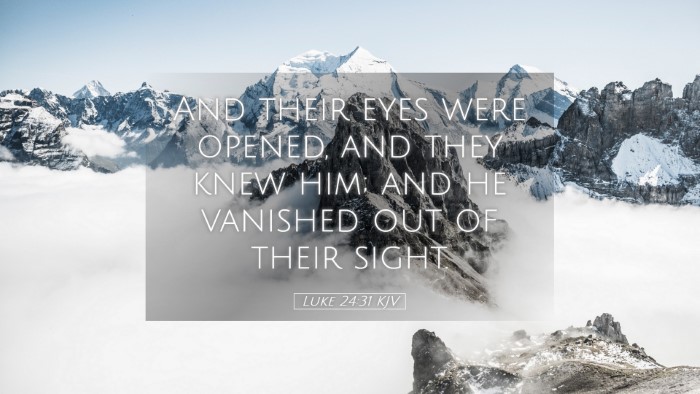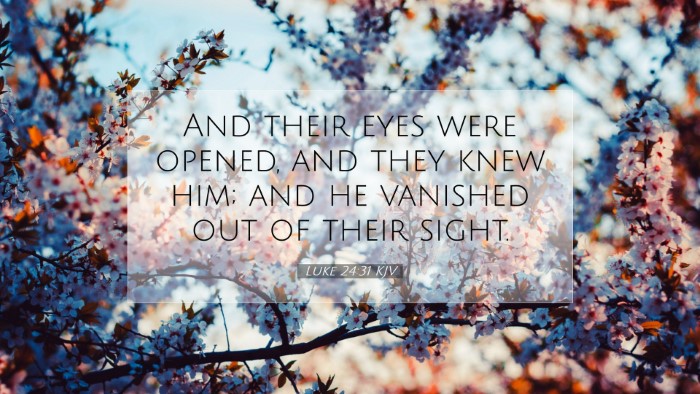Commentary on Luke 24:31
Luke 24:31 states: "And their eyes were opened, and they knew him; and he vanished out of their sight." This verse occurs in a post-resurrection context, where two disciples encounter the risen Christ on the road to Emmaus and later recognize Him during a meal.
Contextual Background
The narrative begins with the crucifixion of Jesus, followed by the confusion and despair experienced by His followers. The two disciples, Cleopas and another unnamed disciple, are conversing about the events that transpired. They are joined by the risen Lord, though they do not initially recognize Him. This setting provides a dramatic backdrop for understanding the significance of their eventual recognition.
Exegesis and Insights
In analyzing Luke 24:31, we draw wisdom from several esteemed public domain commentators:
Matthew Henry's Commentary
Recognition of Christ: Henry emphasizes that the opening of the disciples' eyes signifies divine revelation. It is not simply a physical acknowledgment but a spiritual enlightenment. The timing is crucial; their eyes were opened "at the breaking of bread," indicating that the act of communion or fellowship played a pivotal role in their recognition.
Symbolism of Vanishing: The vanishing of Christ from their sight post-recognition signifies His transcendent nature. Henry notes that Jesus' absence after their realization underscores the necessity of faith and the believer's reliance on the Holy Spirit for guidance, rather than on physical presence.
Albert Barnes' Notes on the Bible
Spiritual Blindness: Barnes discusses the state of spiritual blindness that affects the disciples prior to their recognition. He suggests that this blindness represents the human condition without the illuminating work of the Holy Spirit, demonstrating the need for divine intervention to comprehend spiritual truths.
Breaking of Bread: By highlighting the importance of the breaking of bread, Barnes illustrates how ordinary acts can become extraordinary means of grace. The Lord's Supper serves as a profound reminder of Christ's sacrifice and presence among His people. The disciples’ eyes being opened at this moment hints at the sacramental nature of Christian fellowship.
Adam Clarke's Commentary
Nature of Jesus' Resurrection Body: Clarke focuses on the implications of Jesus vanishing from their sight. He posits that Christ's resurrection body, while tangible, operates under different laws than our physical bodies. This suggests a transformation not only in Christ but also in the mode of existence for His followers post-resurrection.
Faith vs. Sight: Clarke emphasizes the theme of faith prevailing over sight. The disciples did not recognize Jesus until their eyes were opened, which serves as a lesson in spiritual perception; believers are called to trust and recognize Christ even when He is not seen. This truth is vital for pastors and theologians who teach about living by faith.
Theological Implications
This verse is rich with theological implications:
- Revelation: The concept of revelation is central; believers rely on God’s initiative in revealing truth about Himself.
- Communion: The act of "breaking bread" symbolizes not only fellowship with Christ but also the deepening of the relationship among believers.
- Presence of Christ: The vanishing of the Lord after He is recognized highlights that Christ's presence is more profound in faith than in sight.
Application for Pastors and Scholars
Luke 24:31 offers meaningful applications for those in ministry and academia:
- Encouragement in Spiritual Discernment: Pastors can encourage congregations to seek spiritual discernment and sensitivity to Christ’s presence in their lives.
- Teach on the Nature of Communion: This verse serves as an opportunity to teach about the significance of communion as a means of grace and fellowship with Christ.
- Faith Development: Emphasizing reliance on faith in understanding Jesus' nature and presence can help believers navigate doubts and uncertainties.
Conclusion
In sum, Luke 24:31 illustrates a transformational moment in the disciples' journey of faith. The opening of their eyes signifies not just recognition but also the deeper understanding of Jesus’ role as the risen Lord. As public domain commentators such as Matthew Henry, Albert Barnes, and Adam Clarke have shown, this verse encapsulates rich insights into revelation, faith, and the nature of communion. Its applications remain pertinent for pastors, students, and theologians as they seek to understand and communicate the profound truths of the Christian faith.


